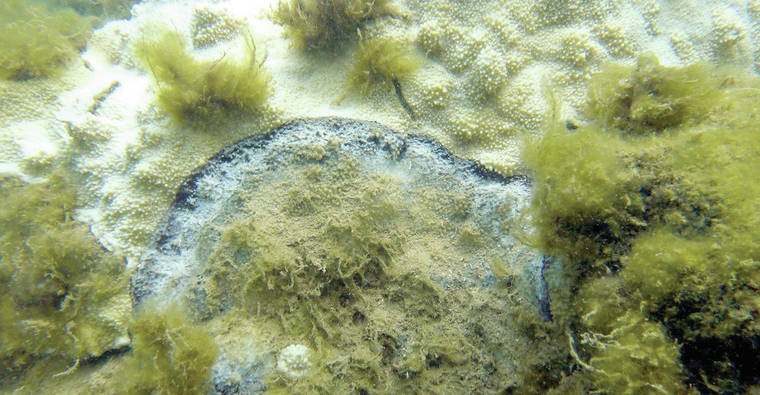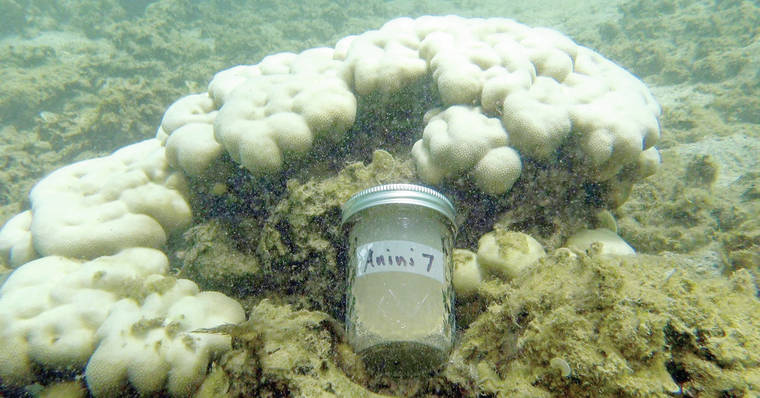LIHUE — The sediment in Anini’s shallow lagoon could be saturated with heavy metals, according to results from a study conducted through volunteers with the nonprofit Reef Guardians Hawaii.
Sediment samples were taken from the Anini reef on Kauai’s North Shore in August after underwater photographer Terry Lilley documented a coral-bleaching event in the area.
The reef holds just some of the corals in Hawaii waters that are experiencing bleaching in the midst of a marine heat wave that has encompassed the islands.
The sediment test is one of many research projects with multiple organizations and universities worldwide, all working toward the same end goal of understanding how corals are impacted by not only marine heat waves, but by other factors in the environment.
Ocean-goers and scientists started seeing bleaching in May 2019. In September, the University of Hawaii School of Ocean and Earth Science and Technology released what they called the largest study of coral communities, which identified ways to protect coral reefs.
The study cites climate change and human impacts as major threats to the reefs, specifically increasing carbon emissions, overfishing, pollution and unsustainable development. Authors also suggest three ways to combat those threats — protect, recover and transform.
“Protect” focuses on safeguarding the world’s last functioning reefs. “Recover” focuses on promoting recovery in areas that were previously functioning but impacted by the 2014 to 2017 bleaching event. “Transform” points out the need for coastal communities to move away from relying on reefs that are no longer functioning.
“The study provides a roadmap for reef managers to identify areas that can benefit from active management practices at a local scale while also preparing for potential future impacts from increasing climate hazards,” stated Erik Franklin, co-author of the study and assistant research professor at the Hawaii Institute of Marine Biology, in a release about the study.
More than 80 authors contributed to the study. According to UH, they surveyed coral abundance on more than 2,500 reefs throughout 44 different countries in the Indian and Pacific oceans.
Lead author Emily Darling, who is a Wildlife Conservation Society Conservation scientist and leader of the WCS global coral reef monitoring program, said the study did provide some good news — the reefs can still be saved.
“Safeguarding coral reefs into the future means protecting the world’s last functioning reefs and recovering reefs impacted by climate change. But realistically – on severely degraded reefs – coastal societies will need to find new livelihoods for the future,” Darling said in the release.
Authors of the study found areas with more framework corals, which are the coral species that build the “backbone” of the reef, occurred in areas with fewer climate shocks and longer recovery windows, and in places farther from coastal populations, “with associated agricultural impacts.”
The sediment study also points to the potential that runoff from the coastal populations could be impacting the coral, particularly at the Anini reef.
In a release about the Anini sediment study, those authors said they found high concentrations of iron in their samples, and high nitrogen levels on corals infected with black band disease.
“We have excess nitrogen coming from somewhere,” Lilley said. “The near shore samples (have) less nitrogen than the samples further out on the coral reef, so this tells us the nitrogen is not coming from the land directly.”
Authors suggested the nitrogen and iron could be entering the water through Kalihiwai River or through fresh water seeps, or it could be coming from another unlikely source — remnants of Kauai’s 2018 record-breaking flood.
“I did a scuba dive in the middle of the Kalihiwai Bay, and it is filled with decaying giant trees and wood that flowed into the bay from the massive 2018 flood,” Lilley said. “This wood may be decaying and producing excess nitrogen that may be harming the coral reef.”
He pointed out the iron could also be a result of the flood, transported through sediment that was washed to the ocean from the mountains.
Meanwhile, the SOEST study’s findings pointed out a need for local management of impacted areas and a global need to limit carbon emissions.
•••
Jessica Else, environment reporter, can be reached at 245-0452 or jelse@thegardenisland.com.







I lived on Anini almost 20 years ago at “Glo Manor” and noticed there was a water flow from Princeville Golf Courses up above. I called the environmental people then because I could see a change in the reef and the stream going out to the reef from the waterfall. The chemicals that is/was being put on the golf courses for bugs and beauty was being washed down the drainoff/waterfall to the stream that went right by Glo Manor and on out to the reef!!!! My reply was that “until they saw the fish dying from it, there was nothing they could do”!!!! Wouldn’t that be too late?!
Source of contamination: GOLF COURSES
Wake up people, these fields are as poisonous to the reefs as it can be
Uh guys. Iron is very common in the igneous rock of Kauai- that’s why the dirt is red! And iron is not a “heavy metal”. More bogus science. These guys did the same nonsense on the Hanalei River.
Important point
Uh, guy. Your argument doesn’t make any sense.